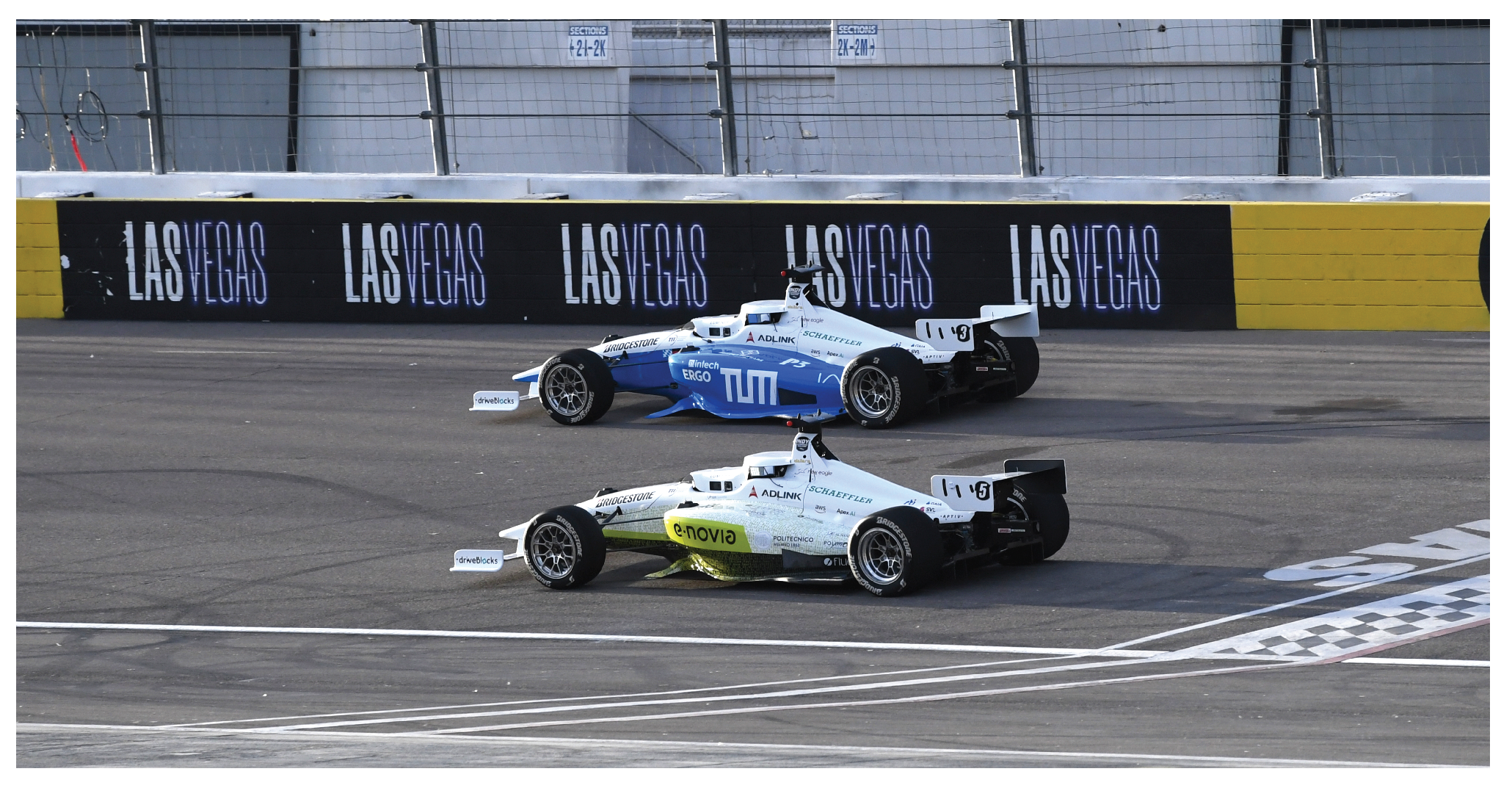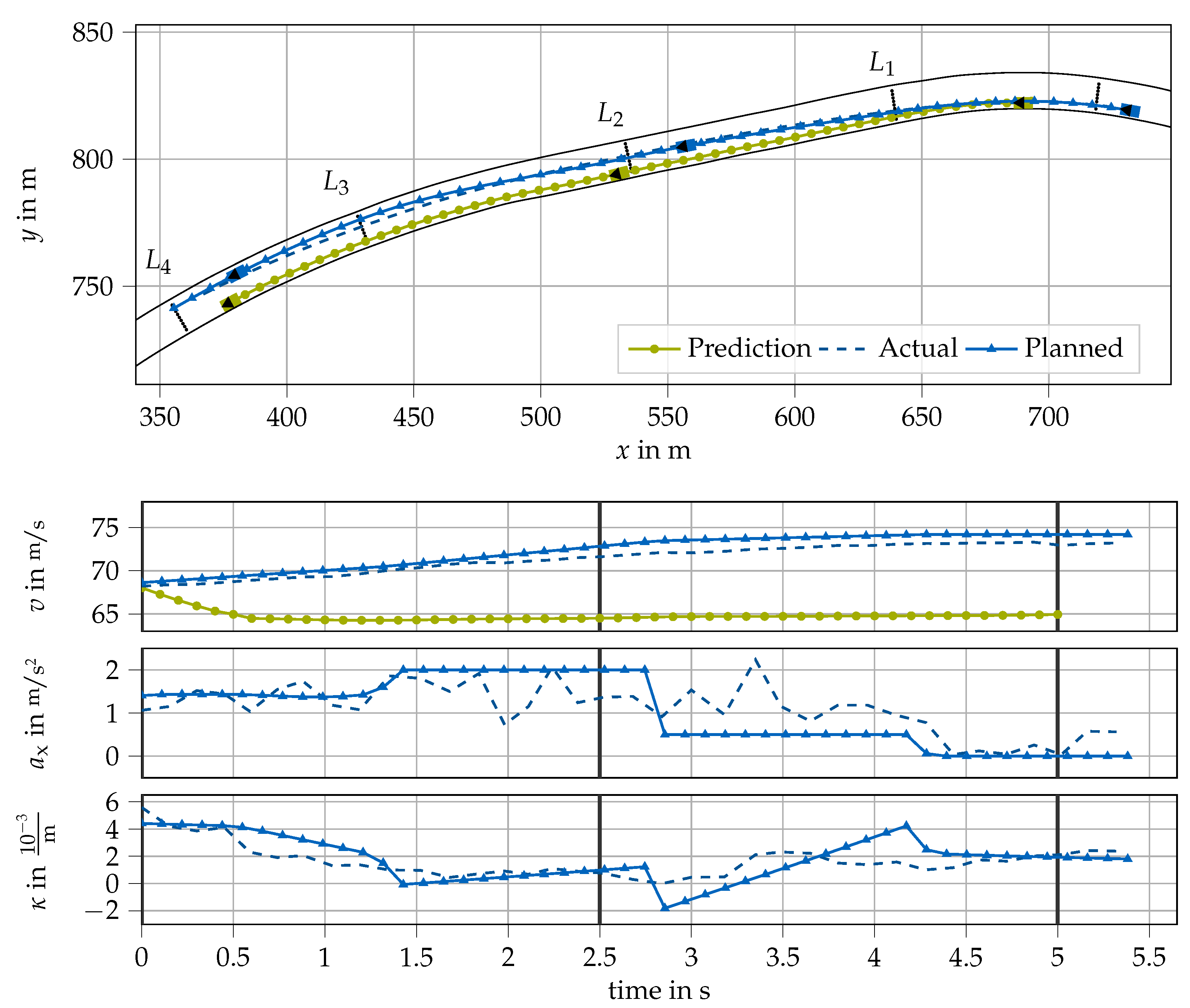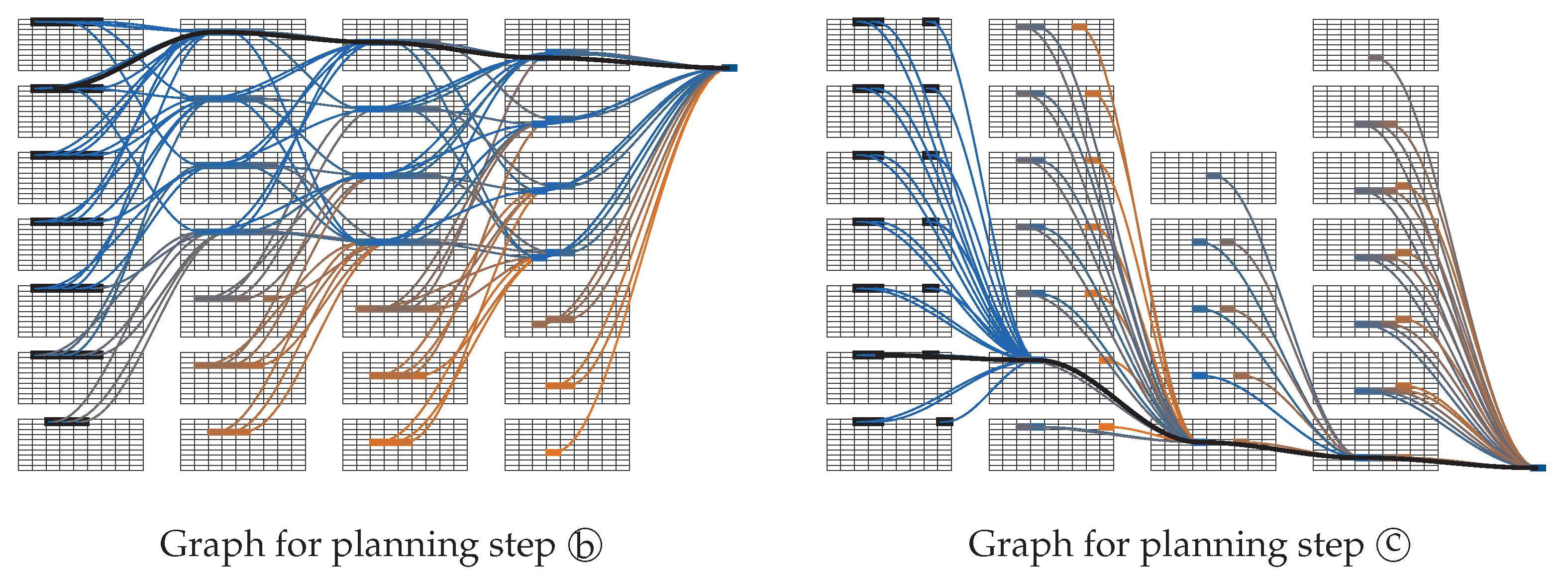Efficient Spatiotemporal Graph Search for Local Trajectory Planning on Oval Race Tracks
Abstract
1. Introduction
- (1)
- The race track offers many maneuver variants to be considered, since the presence of other vehicles constitutes a nonconvex problem. A sufficiently long planning horizon is required and a short computation time is desired, which further complicates the search for the optimal solution.
- (2)
- One must ensure that the planning problem remains solvable in the next planning step. In the field of model predictive control (MPC) this is known as recursive feasibility. An illustrative example in the context of racing is a braking point before a sharp turn that, if not correctly determined, could lead to a planning problem with no feasible safe solution due to excessive speed at the turn entry.
- (3)
- The used cost function should result in safe but competitive behaviors in all scenarios.
- (4)
- Newly detected obstacles or falsely predicted vehicles require fast reactions. Therefore, the computation time for generating a trajectory in the new environment should be as short as possible.
1.1. Related Work
1.2. Contribution
- In contrast to [26,27], we perform a uniform-cost search (UCS) to find the cost-minimal path in the spatiotemporal graph and show that the search can significantly reduce the computation time compared to the originally proposed exhaustive search. We explain under which conditions and how the UCS can be applied to the interval-based graph structure.
- We extend the UCS to be anytime capable for the interval-based graph structure. Therefore, we maintain a set of candidate goal nodes in the graph that must be updated during the search. With this set, the search can terminate early and provide a suboptimal solution even before the optimal solution is found, e.g., due to computation time constraints or an appearing obstacle that requires immediate replanning.
- We propose a cost function for search-based planning approaches suited for racing and explain how it affects the graph search. This has been tested for a fully autonomous operation on an oval race track, including pit lane driving, racing line following, and overtaking maneuvers.
1.3. Structure
2. Materials and Methods
2.1. Local Planning Concept
- A global racing line serving as a reference must be precomputed offline. This can be the, e.g., curvature-minimal or time-optimal trajectory for the closed race track. The racing line enters the cost function so that the local planning approach follows the racing line whenever possible.
- The result of our proposed graph search is a coarse trajectory. It can be curvature- and acceleration-discontinuous, encoding more a behavioral decision than a path with a velocity profile that should be tracked precisely. Therefore, a subsequent smoothing procedure should be performed so that a tracking controller can execute the planned motion. Alternatively, the used tracking controller can handle the discontinuous profiles such as the one used in Section 3.
- Following a sequential pipeline, the planning approach requires the positions of static and predictions of dynamic obstacles as inputs. Interaction-aware planning must be realized via the cost function so that iterations with alternating prediction and planning steps as in [35] or iterated best response algorithms as in [34] are not possible. An example of how interactions can enter the cost function is given in [36].
- Before the planning step, the new trajectory’s initial state must be determined. It should lie on the trajectory generated in the previous planning step to maintain possible tracking errors and clearly separate the planning from the tracking task. As in [8], the selection of the initial state can be based on the expected calculation time of the planning approach to account for the motion along the previous trajectory while the new trajectory is not yet available.
- The initial state must be connected to the spatiotemporal graph at the nodes where the search begins. The method used in Section 3 samples longitudinal and lateral polynomials, so we call it a sampling procedure from here on. The sampling procedure should generate a set of diverse trajectory segments, called initial edges, which connect the initial state with multiple nodes in the spatiotemporal graph.
2.2. Spatial Graph
2.3. Spatiotemporal Graph
2.4. Graph Search
2.4.1. Exhaustive Search
2.4.2. Uniform-Cost Search
| Algorithm 1 UCS with suboptimal goal nodes |
|
2.5. Cost Function
3. Results and Discussion
3.1. Overtaking Maneuver
3.2. Comparison of the Search Methods
4. Conclusions and Outlook
Author Contributions
Funding
Data Availability Statement
Acknowledgments
Conflicts of Interest
Abbreviations
| LVMS | Las Vegas Motor Speedway |
| IMS | Indianapolis Motor Speedway |
| IAC | Indy Autonomous Challenge |
| AC@CES | Autonomous Challenge at CES |
| RRT | Rapidly exploring random trees |
| UCS | Uniform-cost search |
| TUM | Technical University of Munich |
| MPC | Model predictive control |
| OCP | Optimal control problem |
| NLP | Nonlinear programming |
| PVD | Path-velocity decomposition |
References
- Buehler, M.; Iagnemma, K.; Singh, S. (Eds.) The 2005 DARPA Grand Challenge; Springer Tracts in Advanced Robotics; Springer: Berlin/Heidelberg, Germany, 2007; Volume 36. [Google Scholar] [CrossRef]
- Buehler, M.; Iagnemma, K.; Singh, S. (Eds.) The DARPA Urban Challenge; Springer Tracts in Advanced Robotics; Springer: Berlin/Heidelberg, Germany, 2009; Volume 56. [Google Scholar] [CrossRef]
- Theodosis, P.A.; Gerdes, J.C. Nonlinear Optimization of a Racing Line for an Autonomous Racecar Using Professional Driving Techniques. In Proceedings of the ASME 5th Annual Dynamic Systems and Control Division Conference and JSME 11th Motion and Vibration Conference, Fort Lauderdale, FL, USA, 17–19 October 2012; ASME: New York, NY, USA, 2013; pp. 235–241. [Google Scholar] [CrossRef]
- Heilmeier, A.; Wischnewski, A.; Hermansdorfer, L.; Betz, J.; Lienkamp, M.; Lohmann, B. Minimum curvature trajectory planning and control for an autonomous race car. Veh. Syst. Dyn. 2020, 58, 1497–1527. [Google Scholar] [CrossRef]
- Roborace. Available online: https://roborace.com/ (accessed on 2 November 2022).
- Kant, K.; Zucker, S.W. Toward Efficient Trajectory Planning: The Path-Velocity Decomposition. Int. J. Robot. Res. 1986, 5, 72–89. [Google Scholar] [CrossRef]
- Paden, B.; Cap, M.; Yong, S.Z.; Yershov, D.; Frazzoli, E. A Survey of Motion Planning and Control Techniques for Self-Driving Urban Vehicles. IEEE Trans. Intell. Veh. 2016, 1, 33–55. [Google Scholar] [CrossRef]
- Ziegler, J.; Bender, P.; Dang, T.; Stiller, C. Trajectory Planning for Bertha—A Local, Continuous Method. In Proceedings of the 2014 IEEE Intelligent Vehicles Symposium Proceedings, Dearborn, MI, USA, 8–11 June 2014; IEEE: Piscataway, NJ, USA, 2014; pp. 450–457. [Google Scholar] [CrossRef]
- Cremean, L.B.; Foote, T.B.; Gillula, J.H.; Hines, G.H.; Kogan, D.; Kriechbaum, K.L.; Lamb, J.C.; Leibs, J.; Lindzey, L.; Rasmussen, C.E.; et al. Alice: An Information-Rich Autonomous Vehicle for High-Speed Desert Navigation. In The 2005 DARPA Grand Challenge; Springer Tracts in Advanced Robotics; Buehler, M., Iagnemma, K., Singh, S., Eds.; Springer: Berlin/Heidelberg, Germany, 2007; Volume 36, pp. 437–482. [Google Scholar] [CrossRef]
- Veneri, M.; Massaro, M. A free-trajectory quasi-steady-state optimal-control method for minimum lap-time of race vehicles. Veh. Syst. Dyn. 2020, 58, 933–954. [Google Scholar] [CrossRef]
- Lovato, S.; Massaro, M. A three-dimensional free-trajectory quasi-steady-state optimal-control method for minimum-lap-time of race vehicles. Veh. Syst. Dyn. 2022, 60, 1512–1530. [Google Scholar] [CrossRef]
- Casanova, D. On Minimum Time Vehicle Manoeuvring: The Theoretical Optimal Lap. Ph.D. Thesis, Cranfield University, Silsoe, UK, 2000. [Google Scholar]
- Christ, F.; Wischnewski, A.; Heilmeier, A.; Lohmann, B. Time-optimal trajectory planning for a race car considering variable tyre-road friction coefficients. Veh. Syst. Dyn. 2021, 59, 588–612. [Google Scholar] [CrossRef]
- Gundlach, I.; Konigorski, U. Modellbasierte Online-Trajektorienplanung für zeitoptimale Rennlinien. Automatisierungstechnik 2019, 67, 799–813. [Google Scholar] [CrossRef]
- Subosits, J.K.; Gerdes, J.C. From the Racetrack to the Road: Real-Time Trajectory Replanning for Autonomous Driving. IEEE Trans. Intell. Veh. 2019, 4, 309–320. [Google Scholar] [CrossRef]
- Zhu, Z.; Schmerling, E.; Pavone, M. A Convex Optimization Approach to Smooth Trajectories for Motion Planning with Car-Like Robots. In Proceedings of the 2015 54th IEEE Conference on Decision and Control (CDC), Osaka, Japan, 15–18 December 2015; IEEE: Piscataway, NJ, USA, 2015; pp. 835–842. [Google Scholar] [CrossRef]
- Xin, L.; Kong, Y.; Li, S.E.; Chen, J.; Guan, Y.; Tomizuka, M.; Cheng, B. Enable faster and smoother spatio-temporal trajectory planning for autonomous vehicles in constrained dynamic environment. Proc. Inst. Mech. Eng. Part D J. Automob. Eng. 2021, 235, 1101–1112. [Google Scholar] [CrossRef]
- Liniger, A.; Domahidi, A.; Morari, M. Optimization-based autonomous racing of 1:43 scale RC cars. Optim. Control. Appl. Methods 2015, 36, 628–647. [Google Scholar] [CrossRef]
- Svensson, L.; Bujarbaruah, M.; Kapania, N.R.; Torngren, M. Adaptive Trajectory Planning and Optimization at Limits of Handling. In Proceedings of the 2019 IEEE/RSJ International Conference on Intelligent Robots and Systems (IROS), Macau, China, 3–8 November 2019; IEEE: Piscataway, NJ, USA, 2019; pp. 3942–3948. [Google Scholar] [CrossRef][Green Version]
- Bender, P.; Tas, O.S.; Ziegler, J.; Stiller, C. The Combinatorial Aspect of Motion Planning: Maneuver Variants in Structured Environments. In Proceedings of the 2015 IEEE Intelligent Vehicles Symposium (IV), Seoul, Korea, 28 June–1 July 2015; IEEE: Piscataway, NJ, USA, 2015; pp. 1386–1392. [Google Scholar] [CrossRef]
- Li, B.; Yin, Z.; Ouyang, Y.; Zhang, Y.; Zhong, X.; Tang, S. Online Trajectory Replanning for Sudden Environmental Changes during Automated Parking: A Parallel Stitching Method. IEEE Trans. Intell. Veh. 2022, 7, 748–757. [Google Scholar] [CrossRef]
- He, S.; Zeng, J.; Sreenath, K. Autonomous Racing with Multiple Vehicles using a Parallelized Optimization with Safety Guarantee using Control Barrier Functions. In Proceedings of the 2022 International Conference on Robotics and Automation (ICRA), Philadelphia, PA, USA, 23–27 May 2022; IEEE: Piscataway, NJ, USA, 2022; pp. 3444–3451. [Google Scholar] [CrossRef]
- Stahl, T.; Wischnewski, A.; Betz, J.; Lienkamp, M. Multilayer Graph-Based Trajectory Planning for Race Vehicles in Dynamic Scenarios. In Proceedings of the 2019 IEEE Intelligent Transportation Systems Conference (ITSC), Auckland, New Zealand, 27–30 October 2019; IEEE: Piscataway, NJ, USA, 2019; pp. 3149–3154. [Google Scholar] [CrossRef]
- Werling, M.; Ziegler, J.; Kammel, S.; Thrun, S. Optimal Trajectory Generation for Dynamic Street Scenarios in a Frenét Frame. In Proceedings of the 2010 IEEE International Conference on Robotics and Automation, Anchorage, AK, USA, 3–7 May 2010; IEEE: Piscataway, NJ, USA, 2010; pp. 987–993. [Google Scholar] [CrossRef]
- Raji, A.; Liniger, A.; Giove, A.; Toschi, A.; Musiu, N.; Morra, D.; Verucchi, M.; Caporale, D.; Bertogna, M. Motion Planning and Control for Multi Vehicle Autonomous Racing at High Speeds. In Proceedings of the 2022 IEEE International Conference on Intelligent Transportation Systems (IEEE ITSC 2022), Macau, China, 8–12 October 2022; IEEE: Piscataway, NJ, USA, 2022. [Google Scholar]
- Ziegler, J.; Stiller, C. Spatiotemporal state lattices for fast trajectory planning in dynamic on-road driving scenarios. In Proceedings of the 2009 IEEE/RSJ International Conference on Intelligent Robots and Systems, St. Louis, MO, USA, 10–15 October 2009; IEEE: Piscataway, NJ, USA, 2009; pp. 1879–1884. [Google Scholar] [CrossRef]
- McNaughton, M.; Urmson, C.; Dolan, J.M.; Lee, J.W. Motion Planning for Autonomous Driving with a Conformal Spatiotemporal Lattice. In Proceedings of the 2011 IEEE International Conference on Robotics and Automation, Shanghai, China, 9–13 May 2011; IEEE: Piscataway, NJ, USA, 2011; pp. 4889–4895. [Google Scholar] [CrossRef]
- Morsali, M.; Frisk, E.; Aslund, J. Spatio-Temporal Planning in Multi-Vehicle Scenarios for Autonomous Vehicle Using Support Vector Machines. IEEE Trans. Intell. Veh. 2021, 6, 611–621. [Google Scholar] [CrossRef]
- LaValle, S.M. Rapidly-Exploring Random Trees: A New Tool for Path Planning. Technical Report 98-11; Iowa State University, Department of Computer Science: Ames, IA, USA, 1998. [Google Scholar]
- Arslan, O.; Berntorp, K.; Tsiotras, P. Sampling-based Algorithms for Optimal Motion Planning Using Closed-loop Prediction. In Proceedings of the 2017 IEEE International Conference on Robotics and Automation (ICRA), Singapore, 29 May–3 June 2017; IEEE: Piscataway, NJ, USA, 2017; pp. 4991–4996. [Google Scholar] [CrossRef]
- Feraco, S.; Luciani, S.; Bonfitto, A.; Amati, N.; Tonoli, A. A local trajectory planning and control method for autonomous vehicles based on the RRT algorithm. In Proceedings of the 2020 AEIT International Conference of Electrical and Electronic Technologies for Automotive (AEIT AUTOMOTIVE), Turin, Italy, 18–20 November 2020; IEEE: Piscataway, NJ, USA, 2020; pp. 1–6. [Google Scholar] [CrossRef]
- Liniger, A.; Lygeros, J. A Viability Approach for Fast Recursive Feasible Finite Horizon Path Planning of Autonomous RC Cars. In Proceedings of the 18th International Conference on Hybrid Systems: Computation and Control, Seattle, WA, USA, 14–16 April 2015; Girard, A., Sankaranarayanan, S., Eds.; ACM: New York, NY, USA, 2015; pp. 1–10. [Google Scholar] [CrossRef]
- Liniger, A.; Lygeros, J. A Noncooperative Game Approach to Autonomous Racing. IEEE Trans. Control. Syst. Technol. 2020, 28, 884–897. [Google Scholar] [CrossRef]
- Wang, M.; Wang, Z.; Talbot, J.; Gerdes, J.C.; Schwager, M. Game-Theoretic Planning for Self-Driving Cars in Multivehicle Competitive Scenarios. IEEE Trans. Robot. 2021, 37, 1313–1325. [Google Scholar] [CrossRef]
- Bahram, M.; Lawitzky, A.; Friedrichs, J.; Aeberhard, M.; Wollherr, D. A Game-Theoretic Approach to Replanning-Aware Interactive Scene Prediction and Planning. IEEE Trans. Veh. Technol. 2016, 65, 3981–3992. [Google Scholar] [CrossRef]
- Fisac, J.F.; Bronstein, E.; Stefansson, E.; Sadigh, D.; Sastry, S.S.; Dragan, A.D. Hierarchical Game-Theoretic Planning for Autonomous Vehicles. In Proceedings of the 2019 International Conference on Robotics and Automation (ICRA), Montreal, QC, Canada, 20–24 May 2019; IEEE: Piscataway, NJ, USA, 2019; pp. 9590–9596. [Google Scholar] [CrossRef]
- Bellman, R. Dynamic Programming; Princeton University Press: Princeton, NJ, USA, 1957. [Google Scholar]
- Hermansdorfer, L.; Betz, J.; Lienkamp, M. Benchmarking of a software stack for autonomous racing against a professional human race driver. In Proceedings of the 2020 Fifteenth International Conference on Ecological Vehicles and Renewable Energies (EVER), Monte-Carlo, Monaco, 10–12 September 2020; IEEE: Piscataway, NJ, USA, 2020; pp. 1–8. [Google Scholar] [CrossRef]
- Herrmann, T.; Wischnewski, A.; Hermansdorfer, L.; Betz, J.; Lienkamp, M. Real-Time Adaptive Velocity Optimization for Autonomous Electric Cars at the Limits of Handling. IEEE Trans. Intell. Veh. 2021, 6, 665–677. [Google Scholar] [CrossRef]
- Betz, J.; Betz, T.; Fent, F.; Geisslinger, M.; Heilmeier, A.; Hermansdorfer, L.; Herrmann, T.; Huch, S.; Karle, P.; Lienkamp, M.; et al. TUM Autonomous Motorsport: An Autonomous Racing Software for the Indy Autonomous Challenge. arXiv 2022, arXiv:2205.15979. [Google Scholar] [CrossRef]
- Dijkstra, E.W. A Note on Two Problems in Connexion with Graphs. Numer. Math. 1959, 1, 269–271. [Google Scholar] [CrossRef]
- Felner, A. Position Paper: Dijkstra’s Algorithm versus Uniform Cost Search or a Case Against Dijkstra’s Algorithm. In Proceedings of the The Fourth International Symposium on Combinatorial Search (SoCS-2011), Barcelona, Spain, 15–16 July 2011; pp. 47–51. [Google Scholar]
- Russell, S.J.; Norvig, P. Artificial Intelligence: A Modern Approach, 3rd ed.; Prentice Hall: Upper Saddle River, NJ, USA, 2010. [Google Scholar]
- Indy Autonomous Challenge. Available online: https://www.indyautonomouschallenge.com/ (accessed on 2 November 2022).
- Wischnewski, A.; Herrmann, T.; Werner, F.; Lohmann, B. A Tube-MPC Approach to Autonomous Multi-Vehicle Racing on High-Speed Ovals. IEEE Trans. Intell. Veh. 2022, 1. [Google Scholar] [CrossRef]
- Ögretmen, L.; Rowold, M.; Ochsenius, M.; Lohmann, B. Smooth Trajectory Planning at the Handling Limits for Oval Racing. Actuators, 2022; accepted. [Google Scholar]









Publisher’s Note: MDPI stays neutral with regard to jurisdictional claims in published maps and institutional affiliations. |
© 2022 by the authors. Licensee MDPI, Basel, Switzerland. This article is an open access article distributed under the terms and conditions of the Creative Commons Attribution (CC BY) license (https://creativecommons.org/licenses/by/4.0/).
Share and Cite
Rowold, M.; Ögretmen, L.; Kerbl, T.; Lohmann, B. Efficient Spatiotemporal Graph Search for Local Trajectory Planning on Oval Race Tracks. Actuators 2022, 11, 319. https://doi.org/10.3390/act11110319
Rowold M, Ögretmen L, Kerbl T, Lohmann B. Efficient Spatiotemporal Graph Search for Local Trajectory Planning on Oval Race Tracks. Actuators. 2022; 11(11):319. https://doi.org/10.3390/act11110319
Chicago/Turabian StyleRowold, Matthias, Levent Ögretmen, Tobias Kerbl, and Boris Lohmann. 2022. "Efficient Spatiotemporal Graph Search for Local Trajectory Planning on Oval Race Tracks" Actuators 11, no. 11: 319. https://doi.org/10.3390/act11110319
APA StyleRowold, M., Ögretmen, L., Kerbl, T., & Lohmann, B. (2022). Efficient Spatiotemporal Graph Search for Local Trajectory Planning on Oval Race Tracks. Actuators, 11(11), 319. https://doi.org/10.3390/act11110319




